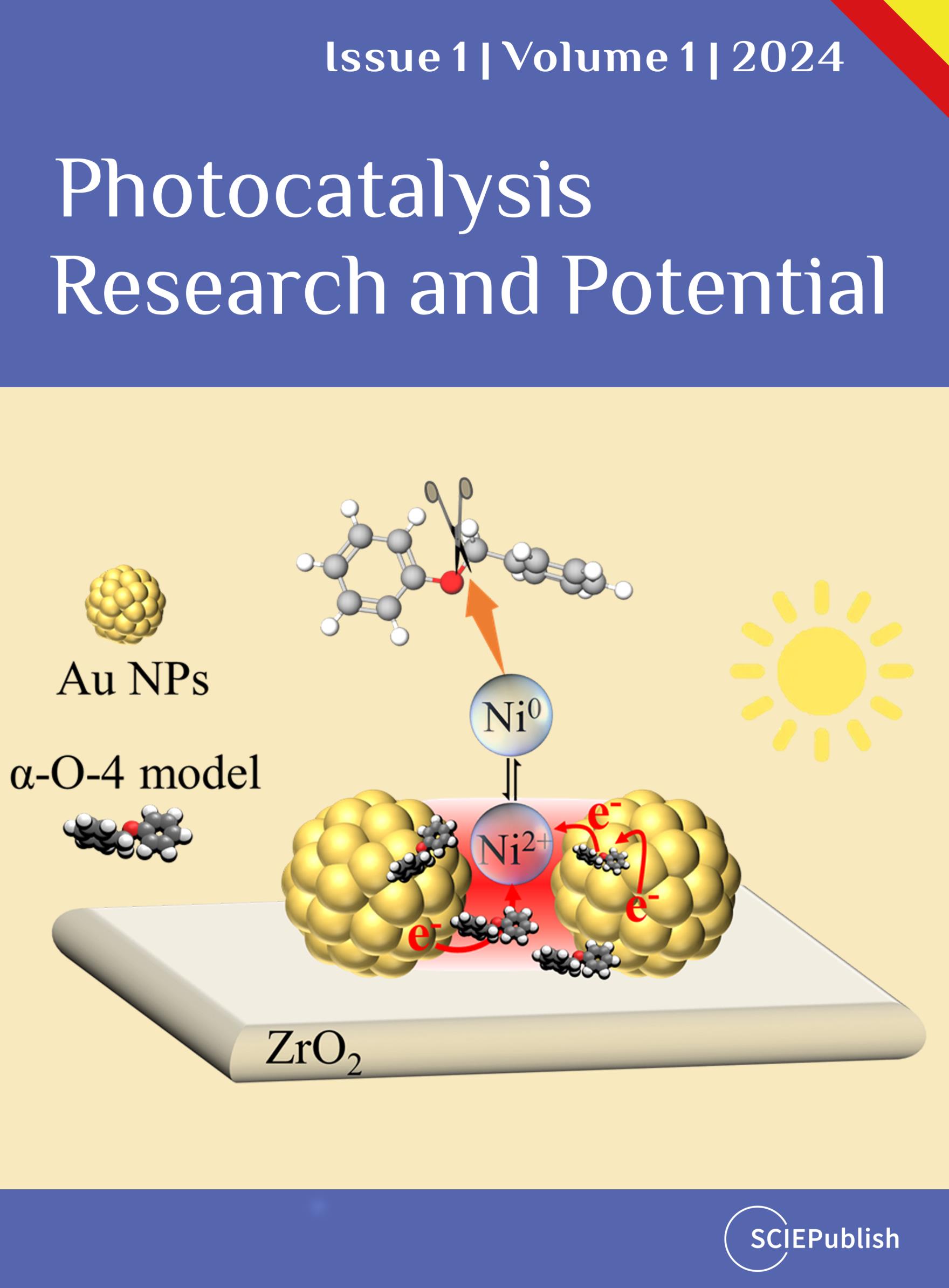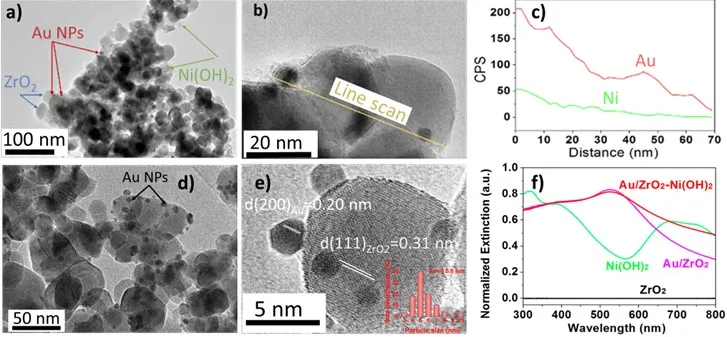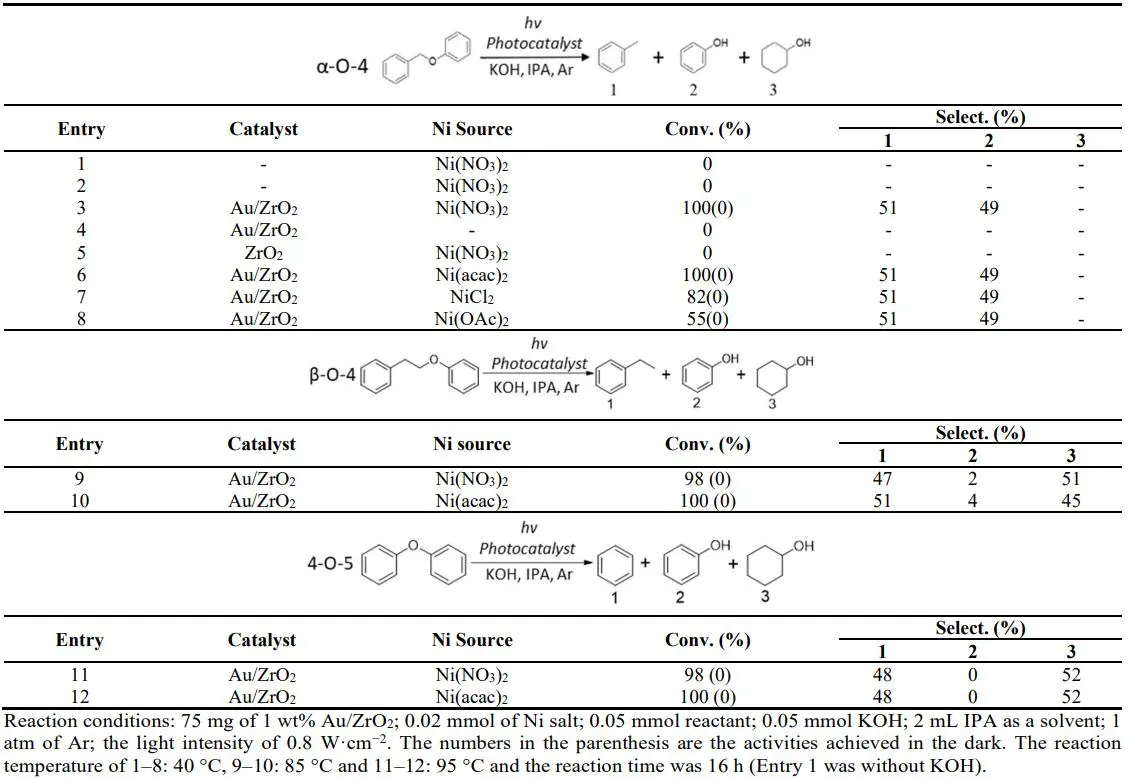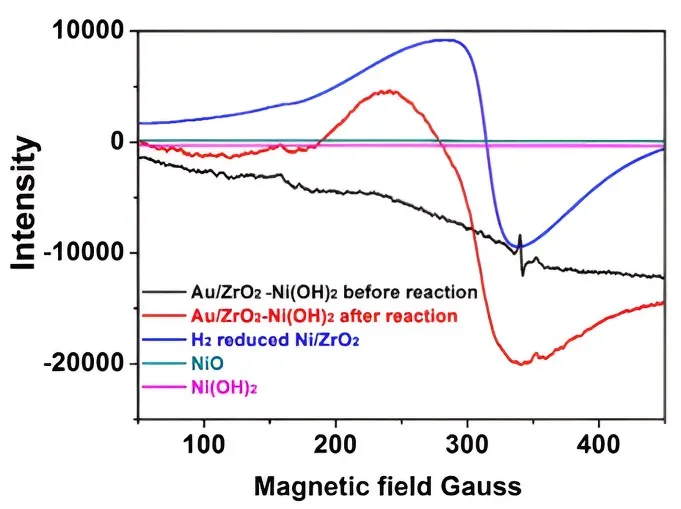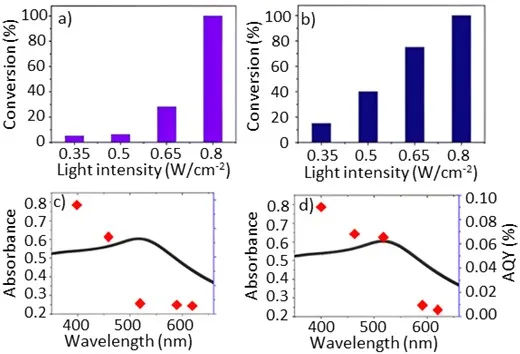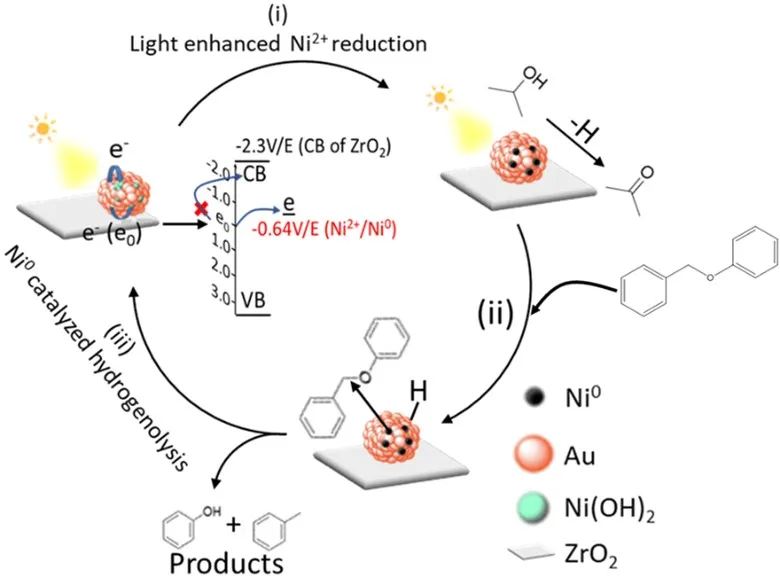Contents
Plasmon Enhanced Nickel(II) Catalyst for Photocatalytic Lignin Model Cleavage
Author Information
Other Information
1
School of Chemistry and Physics, Faculty of Science, Queensland University of Technology, Brisbane, QLD 4001, Australia
2
Engineering Research Center of Eco-environment in Three Gorges Reservoir Region, Three Gorges University, Yichang 443002, China
*
Authors to whom correspondence should be addressed.
†
The authors made an equal contribution to the work.
Received: 22 November 2022 Revised: 30 November 2022 Accepted: 17 January 2023 Published: 07 February 2023
© 2023 The authors. This is an open access article under the Creative Commons Attribution 4.0 International License (https://creativecommons.org/licenses/by/4.0/).
Photocatal. Res. Potential
2024,
1(1), 10002;
DOI: 10.35534/prp.2023.10002
ABSTRACT:
Photocatalytic-induced cleaving of the ether C–O bond in model lignin compounds was studied with a closely-coupled compo-site material consisting of Ni(OH)2 and gold nanoparticles (NPs) on a zirconia support (Au/ZrO2–Ni(OH)2). The three important ether bond types consisting of α-O-4, β-O-4, and 4-O-5 linkages can all be cleaved using this catalyst at reaction temperatures 40, 85 and 95 °C when under low-flux visible light irradiation. The Au NPs action as a light-harvesting antenna provided light-generated hot electrons that reduced Ni2+ to Ni0. The Ni0 was the active catalytic site where reductive cleavage of ether C–O bonds occurred while it was oxidized to Ni2+ to complete the catalysis cycle. The plasmonic antenna system with supported Ni(OH)2 exhibited better ability for the catalytic reductive ether cleavages under visible light irradiation compared to photocata-lysts of Au NPs and Ni2+ ions immobilized on alumina fibers.
Keywords:
Lignin model cleavage; Photocatalysis;
LSPR effect; Mild conditions
1. Introduction
Lignocellulose is an abundant biomass feedstock that can be converted to fuels and high-value chemicals [1,2,3,4,5]. Lignin is one of three main components of lignocellulose and has great potential utility for the production of value-added chemicals and biofuels [5,6,7,8,9]. There are three important types of ether C–O bonds in lignocellulose, either β-O-4, α-O-4, and 4-O-5 linkages, where the effective transformation of lignin compounds cannot be efficiently achieved using conventional chemical processes due to the inactive nature of these ether C–O bonds [10]. The ether cleavage problem has been extensively studied with many catalyst materials [10,11,12]. Ni-based catalysts are frequently used for the reductive cleavage of these linkages in conventional thermal processing. An unfortunate consequence of the harsh reaction conditions required to activate the stable C–O linkages in these processing routes, such as high reaction temperature and high hydrogen pressure, is that they cause side reactions to occur, while the process is also energy-intensive.
The localized surface plasmon resonance (LSPR) effect of the plasmonic metals (gold, silver, copper) NPs has recently been utilized in developing new photocatalysis processes under moderate reaction conditions [13,14,15,16,17]. The enhanced electromagnetic (EM) near-field of the irradiated plasmonic metal NPs and the light excitation of hot electrons are two of the main physical effects that drive chemical reactions with light in the presence of these catalyst NPs [18,19,20,21]. We previously reported that for the C–O bond cleavage of benzyl phenyl ether, the light irradiation of supported Ag and Au NPs significantly improved the catalytic activity of Ni2+ complexes that had previously been immobilized onto an inert support [18]. A careful study of the reaction mechanism revealed that light-excited hot electrons transferred from the plasmonic metal NPs to the immobilized Ni2+ ions and reduced them to Ni0 atoms that behaved as active sites that were able to cleave ether C–O linkages. Analysis of electron paramagnetic resonance (EPR) data revealed that light-excited hot electrons transferred from the illuminated plasmonic NPs to the immobilized Ni2+ ions in the presence of aromatic molecules, molecules possessing conjugated π-orbitals [18]. The catalysts were prepared by immobilizing Ni2+ ions onto a metal oxide support by grafting silane with amino-linker groups, and this system exhibited high activity toward α-O-4 linkage cleavage but poor performance toward the cleavage of robust 4-O-5 linkage in similar model substrates.
In the present study, photocatalysts containing Ni2+ were prepared using a simpler and more practical approach: Ni(OH)2 was formed in situ under basic conditions from Ni(NO3)2 and KOH. Ni(OH)2 precipitates were attached to the plasmonic metal Au NPs hosted on ZrO2 support. ZrO2 is inert support for catalytic reactions and does not absorb visible light, and it has the advantage that metal NPs tend to bind strongly to its surface, compared to silica or alumina [13,14]. After the overall catalyst structure was deposited, photoexcited electrons at the Au NPs could transfer to Ni(OH)2, reduce the Ni2+ and generate active catalytic Ni0 species on the outmost surface of the catalyst. The reactant molecules with aromatic ether C–O bonds could readily access these catalytic sites, leading to the cleavage of the ether C–O bonds in the reaction. Furthermore, the reaction was active when nickel(II) acetylacetonate [Ni(acac)2], nickel(II) chloride [NiCl2] and nickel(II) acetate [Ni(OAc)2] were employed as a Ni2+ source. These observations provided additional proof that the illuminated Au NPs can promote the catalysis of Ni(II) species from different nickel salts. This novel Au/ZrO2–Ni(OH)2 catalyst system achieved high conversion of the model aromatic ether compounds, under visible light irradiation, at low reaction temperatures approaching 40 °C, which is much lower than the optimized reaction temperature (90 °C) reported previously for a similar photocatalyst system [18]. This Au/ZrO2–Ni(OH)2 catalyst system also remained stable after the fifth cycle in catalyst recycling studies.
2. Materials and Methods
*2.1. Preparation of Catalysts*
2.1.1. ZrO2 Supported Au Nanoparticles (Au/ZrO2)
The catalysts with gold weight percentages of 0.5%, 1%, 3%, 5% and 10% were prepared by the impregnation-reduction method [13]. For example, 1 wt% Au/ZrO2 was prepared by the following procedure: 2.0 g commercially available ZrO2 powder (particles size less than 100 nm) was dispersed into 10.12 mL of 0.01 M HAuCl4 aqueous solution was added while magnetically stirring. 5.3 mL of 0.1 M lysine was then added to the mixture with vigorous stirring for 30 min to adjust the solution pH to 8–9. To this suspension, 2 mL of 0.35 M NaBH4 solution was added dropwise in 5 min. The mixture was then aged overnight, and then the solid was separated, washed with water for three times and ethanol once, and then dried in a vacuum oven at 60 °C. The dried solid was used directly as the catalyst. Catalysts with other ratios were prepared in a similar method but using different quantities of HAuCl4, lysine and NaBH4.
2.1.2. ZrO2 Supported Ni NPs (Ni/ZrO2)
Catalysts of 5 wt% Ni were prepared by an impregnation-reduction method similar to Au/ZrO2. The only difference is using 85 mL 0.01 M NiCl2 aqueous solution with 1.0 g ZrO2 support.
2.1.3. Reduction of Ni(II) Species in H2 Atmosphere
As-prepared catalyst Ni/ZrO2 above was reduced in a tube furnace and reduced by hydrogen reduction under 5% H2 and Ar gas mixture atmosphere at 600 °C for 1 h.
2.1.4. Au/ZrO2–Ni(OH)2 Catalyst
Au/ZrO2–Ni(OH)2 was prepared during the reaction. For example, 75 mg Au/ZrO2 was added to 0.05 mmol Benzyl Phenyl Ether (α-O-4), 0.05 mmol KOH and 2 mL isopropyl alcohol solution in the 10 mL glass tube. Then 0.02 mmol Ni(NO3)2·6H2O was added to the solution to form Ni(OH)2 by reacting with KOH. Au/ZrO2–Ni(OH)2 can work together directly as a photocatalyst.
*2.2. Photocatalytic Activity Test*
In a typical activity test, a 10 mL reaction tube was used as the reactor. After 0.05 mmol reactant, 0.05 mmol KOH and 75 mg catalyst had been loaded, 0.02 mmol Ni(NO3)2·6H2O was added to the solution to form Ni(OH)2 by reacting with KOH. Argon was bubbled into the reaction solution for 1 min, and the reaction tube was sealed to isolate the reaction from the air. The reaction tube was then stirred magnetically and irradiated with a halogen lamp (from Nelson, 500 W, wavelength in 400–750 nm range; VIC, Australia). The irradiance was set to certain intensity (e.g., 0.5 W/cm2) unless otherwise specified. The reaction temperature was monitored using a thermal camera (FLIR One Pro; QLD, Australia). Without reaction temperature control, light irradiation caused the reaction temperature to increase rapidly. The reactant vessel was therefore cooled to control the reaction temperatures < 70 °C. A heater was used to set reaction temperatures when temperatures > 70 °C were investigated. The control reaction in the dark was conducted using an oil bath placed above a magnetic stirrer, and the reaction tube was wrapped with aluminum foil to isolate the contents from stray light. The temperature of dark reactions was maintained at the same temperature as the corresponding reaction performed under irradiation. At the end of each reaction time, 1 mL aliquots were collected and filtered through a Millipore filter (pore size of 0.45 μm) to remove the particulate matter. The clear liquid-phase products were analyzed with an Agilent 6980 gas chromatography (GC) (Agilent, Santa Clara, CA, USA) using an HP-5 column to analyze the change in the concentrations of reactants and products. An Agilent HP5973 (Agilent) mass spectrometer was used to identify the products.
Action spectrum experiments were conducted with light emitting diode (LED) lamps (Tongyifang, Shenzhen, China) with wavelengths of 395 ± 5 nm, 450 ± 5 nm, 520 ± 5 nm, 590 ± 5 nm, and 620 ± 5 nm. The light intensity at the reaction vial was measured to be 0.2 W/cm2 using an AULTT energy meter (model: CEL-NP2000), and other reaction conditions were kept identical to those of typical reaction procedures. The apparent quantum yield (AQY) was calculated as follows: apparent quantum yield = [(*M*light − *M*dark)/*N*p] × 100%, where *M*light and *M*dark are the molecules of products formed under irradiation and dark conditions, respectively, *M* = mole number of the reactant × conversion × 6.02 × 1023 (Avogadro constant). *N*p is the number of photons involved in the reaction. *N*p = *E*total/*E*1, *E*total (the total energy involved in the reaction irradiation) = intensity × light spot area×reaction time, *E*1 (the energy of one photon) = h × c/λ (h is Planck constant, c is light speed, and λ is the wavelength of the LED light).
*2.3. Catalyst Characterization*
The morphology and elemental composition of photocatalysts were studied using a JEOL 2100 transmission electron microscopy (TEM) equipped with a Gatan Orius SC1000 CCD camera, energy dispersion X-ray (EDX) spectrometer (X-MAXN 80TLE, OXFORD Instruments; JEOL, NSW, Australia) was coupled for elemental analysis. The accelerating voltage of TEM was 200 kV. Diffuse reflectance UV-visible spectra of the catalysts were collected with a Cary 5000 UV-Vis-NIR spectrometer from Agilent company (Santa Clara, CA, USA) using BaSO4 as a blank reference. The scanning scope was 200 nm to 800 nm. X-ray diffraction (XRD) patterns were recorded on a Philips PANalytical X’ Pert PRO diffractometer using Cu Kα radiation (λ = 1.5418 A); the fixed power source was 40 kV and 40 mA. The diffraction data were collected from 5° to 75° at a scanning rate of 2.5°/min with a resolution of 0.01°. X-ray photoelectron spectroscopy (XPS) analysis was performed with a Kratos Axis Ultra photoelectron spectrometer using mono Al Kα (1486.6 eV) X-ray. Inductively coupled plasma-atomic emission spectroscopy (ICP-AES) analysis was performed using a Perkin Elmer 8300 DV ICP (PerkinElmer, MA, USA) fitted with an ESI SC-4DX auto-sampler and PrepFAST 2 sample handling unit for online internal reference and auto-dilution of samples and calibration references. Nitric acid, purified by sub-boiling distillation, was used for the preparation of all references and blank solutions were used throughout the analysis. X-band (ca. 9.77 GHz) continuous-wave (CW) EPR spectra were recorded on a Bruker Biospin Elexsys E500 EPR spectrometer (Bruker, VIC, Australia) fitted with a super-high-Q cavity (CW EPR). Spectra were recorded under the following conditions: room temperature, modulation frequency 100 kHz, modulation amplitude 0.1 mT, and microwave power 20 mW (10 dB).
3. Results and Discussion
Figure 1a contains a transmission electron microscopy (TEM) image of a 1 wt% Au/ZrO2–Ni(OH)2 sample recovered after the reaction. It can be seen that the Ni(OH)2 formations are attached to Au NPs and to the ZrO2 support (Figure 1b). The line scan profile of the sample (Figure 1c) confirms the co-existence of Au and Ni elements. The Au/ZrO2 before and after the Ni(OH)2 assembly exhibited strong absorption in the ultraviolet and visible range of the spectrum (Figure 1f). The ZrO2 support has a large band gap of 5.8 eV and does not absorb light with wavelengths above 400 nm [22]. The initially prepared Ni(OH)2 solution absorbed light with two broad peaks observed at the 382 and 690 nm, assigned to the 3*A*2*g*(*F*)→3T1*g*(*P*) and 3*A*2*g*(*F*)→3*T*1*g*(*F*) transitions of Ni (II) [23,24,25]. The Au/ZrO2–Ni(OH)2 catalyst absorbed light in the visible region with the characteristic LSPR absorption peak centered at 525 nm due to the LSPR effect of Au NPs (with diameters about 5 nm, Figure 1d,e) [26]. More characterization data are given in SI, Table S1 and Figures S1–S4.The photocatalytic performances of the catalysts are provided in Table 1. Optimal photocatalytic activity toward the lignin model compound α-O-4 (dissociation energy 218 kJ/mol) [27] cleavage was observed with the structure composed of 1 wt% Au with Ni(OH)2 on ZrO2 support, where complete conversion of benzyl phenyl ether and high product selectivity were observed under mild conditions and light irradiation.Ni(NO3)2 dissolved in IPA did not exhibit any activity (Entry 1), and adding 1 equivalent of KOH into the reaction did not lead to reactant conversion (Entry 2). Ni(NO3)2 precipitated to Ni(OH)2 in the solution immediately (Figure S5). When 1 wt% Au/ZrO2 was added to the reaction, 100% reactant conversion was achieved, producing the products toluene and phenol at a 1:1 ratio at only 40 °C in 16 h (Entry 3). Au/ZrO2 alone did not lead to a reaction under the same reaction conditions (Entry 4), confirming the synergetic effect of Au/ZrO2 with Ni(OH)2 and light irradiation for catalyzing the reaction. Notably, this synergetic effect is induced by light irradiation, as can be seen by comparing to all the control reactions conducted at the same temperature but without light, which exhibited no reaction activity. ZrO2 and Ni(OH)2 on their own (Entry 5) showed no activity either.
We note that when different Ni salts, Ni(acac)2, NiCl2 and Ni(OAc)2, were used, there was a photo-induced catalytic activity towards α-O-4 cleavage in the presence of Au/ZrO2 (Entry 6–8). The difference in reaction activity within different Ni salts may be due to different nanostructures of Ni(OH)2 formed from different Ni salts [28].
In the photocatalytic conversion of the model molecule with a β-O-4 linkage, the largest fraction of ether bonds in lignin has a high C–O bond dissociation energy of 289 kJ/mol, and the model molecule with a 4-O-5 linkage has a C–O bond dissociation energy of 314 kJ/mol [27], over Au/ZrO2–Ni(OH)2 are presented in Entry 9–12 of Table 1. The result is promising, with 100 % photo-induced conversion achieved at elevated reaction temperatures. The higher temperature is required to achieve the same outcome due to the higher bond energies of the C–O bond of β-O-4 and 4-O-5 linkages. Plasmonic NPs can couple absorbed light and thermal stimuli to generate hot electrons with high energies [18,19,20,21]. The reaction could proceed when the sum of light and thermal energy absorbed by the catalyst was sufficient to overcome the reaction activation energy barrier. The product selectivity observed in reactions with those model reactant compounds containing β-O-4 and 4-O-5 cleavage was towards cyclohexanol rather than phenol, as observed with α-O-4 cleavage under higher temperatures and intense light conditions. This indicated that after the C–O bond was cleaved at the catalyst surface, phenol was further reduced to cyclohexanol. The cleaving of the 4-O-5 linkage represents an exigent challenge; the catalysts we reported upon previously could not achieve it [18]. There was no conversion for both lignin model molecules in dark reactions, which confirms the mechanism of action involved in photo-induced catalytic reactions.
We observed that the catalyst color changed from light purple to dark grey before and after the reaction (Figure S5) and performed EPR analysis on the catalyst samples before and after the reaction, which was also compared with a sample of H2-reduced Ni NPs loaded on ZrO2 (Figure 2). The characteristic peak of paramagnetic Ni0 was observed, similar to when H2-reduced Ni NPs were loaded on ZrO2. This indicates that Ni0 was the intermediate active site formed during the Ni2+-Ni0-Ni2+ cycles. This is consistent with our previous study [18]. Light irradiation is known to generate energetic hot electrons in Au NPs and these photogenerated charges transfer to nearby Ni2+ ions and reduce them to Ni0 atoms. The system produced from Ni(acac)2 exhibited the best catalytic performance (Entries 10 and 12). Acetylacetonate molecules which have a conjugated π orbital system, can act as electronic bridges to transfer hot electrons from illuminated Au NPs to Ni(II) and form the catalytic active Ni0 sites [18].
To better understand how light irradiation influenced photocatalytic performance, a study of the reaction rate dependence on light intensity and wavelength at two different reaction temperatures was investigated. Figure 3a,b shows that the reaction rate considerably increased when the light intensity was increased. At 40 °C, only with high-intensity light irradiation above 0.65 W/cm2 could the reaction progress with significant reactant conversion. 100% conversion was observed when the light intensity was further increased to 0.8 W/cm2 at 40 °C.
Increasing the light intensity during the reaction is expected to produce more hot electrons and thus more Ni0 sites that induce the reductive cleavage [18,26], accelerating the reaction. A study was made of the effect of light intensity, performed at two different reaction temperatures, 40 °C (Figure 3a) and 50 °C (Figure 3b), using the broad-spectrum CW halogen light source which irradiated the samples over a 400–750 nm wavelength range. At 40 °C reaction temperature, the reactant conversion at low light intensity (0.5 W/cm2) was measured to be only 4% (Figure 3a). At a temperature of 50 °C, 0.5 W/cm2 low intensity light induced 39 % conversion of the reactant (Figure 3b). The reaction temperature clearly had a marked effect on the photocatalytic cleavage reaction. Changes to the reaction temperature simultaneously influence several physical properties of the system, including diffusion, reactant adsorption and product desorption. Higher temperature also populates higher energy vibrational states of the surface-bound reactant, which can release energy into the reaction coordinate [29].
The linear dependence indicates a hot electron-driven chemical reaction [30]. In comparison, a nonlinear dependence of the conversion rate on the light intensity is observed at 40 °C (Figure 3a). This indicates that the reaction rate is also determined by other effects in addition to hot electrons, such as reactant diffusion to the active sites and the product diffusion from the catalyst and their adsorption on and desorption from the catalyst. At 50 °C, the diffusion and desorption are faster than at 40 °C. The reaction rate predominantly depends on the number of hot electrons. A linear dependence on the light intensity is observed (Figure 3b).
A one-to-one action spectrum mapping was performed between the wavelength-dependent photocatalytic rate and the light extinction spectrum. Figure 3c,d demonstrates that the irradiation wavelength has a crucial impact on the photocatalytic C–O bond cleavage of α-O-4. We note that the trend of quantum yields does not follow the trend of light absorption at 50 °C. The reaction is only activated at wavelengths shorter than 450 nm. The 395 nm wavelength photons have an energy of ~3.12 eV, which provides sufficient energy to the excited electrons to overcome the energy barrier for the reduction of nearby Ni2+ in Ni(OH)2 to Ni0 [18]. The population of excited electrons is greatly boosted near the LSPR wavelength range, but the electrons excited by the LSPR absorption have insufficient energy to reduce Ni2+ ions and initiate the C–O bond cleavage in α-O-4. These indicate there is an energy threshold to drive the photocatalytic reaction [29]. Hence, at 50 °C or below, the photocatalytic reactions are driven by the hot electrons of the Au NPs, generated by interband electron excitation [18]. At a higher temperature, the population of excited vibrational states of the reactant molecules is greater. It means a reduced activation energy barrier [31]. Also, there are more conducting electrons of plasmonic metal NPs at higher energy levels [19], which can be excited and transferred to Ni2+ sites by photons of longer wavelengths. The energy threshold decreases as the reaction temperature is raised [30]. When the reaction temperature increased to 65 °C, the AQY at the wavelength in the LSPR range (525 nm) showed a great increase (Figure 3d). The light energy in LSPR wavelength can effectively drive the reaction since the LSPR absorption of Au NPs generates a much more hot electrons with energy exceeding the threshold, inducing the reaction. It reveals that moderate heating, which can be achieved by absorption of infrared irradiation of the solar spectrum, will significantly enhance the catalytic performance under irradiation of visible light that accounts for about 45% of the sunlight energy. This knowledge is useful for driving the reaction with sunlight in the future.
To explore the possible mechanism, 1 wt% Au/ZrO2–Ni(OH)2 was calcined at 450 °C in the air for 1 h. In the calcining process, Au NPs aggregated to a larger size at higher temperatures and Ni(OH)2 decomposed to NiO, as confirmed by the FTIR spectrum in Figure S6 (the obtained catalyst is labeled as 1 wt% Au/ZrO2-450-NiO). For comparison, 1 wt% Au/ZrO2 was calcined at 450 °C for 1 h first to achieve the Au NPs of similar sizes. The calcined sample was then used to prepare 1 wt% Au/ZrO2-450-Ni(OH)2 catalyst by precipitating Ni(OH)2 on it with KOH in Ni(NO3)2/IPA solution. The difference between the two catalysts is that one contains NiO and the other Ni(OH)2, while Au/ZrO2 in both catalysts were at the same percentage and morphology. The mean size of Au NPs in the calcined samples increased to 7 nm (Figure S7a) compared to the original 5 nm. The 1 wt% Au/ZrO2-450-Ni(OH)2 exhibits 60 % conversion (Table 2, Entry 1). In contrast, 1 wt% Au/ZrO2-450-NiO showed no conversion (Table 2, Entry 3). It confirms that Ni(OH)2 played an essential role in catalyzing the reaction. We reduced 1 wt% Au/ZrO2-450-NiO by H2 at 550 °C for 30 mins to reduce a part of NiO to Ni0 sites. FTIR results in Figure S8 supported this reduction. The reduced sample showed 11 % conversion without base added (Table 2, Entry 4). These results corroborate that Ni0 is critical for the reaction. Ni2+ ions in the Ni(OH)2 can be readily reduced to Ni0 atoms when receiving the hot electrons from Au NPs. ZrO2 support is inert (with a bandgap of 5.8 eV) [22] and cannot absorb visible light. In contrast, it is difficult to reduce NiO by the hot electrons generated by visible light irradiation on Au NPs to a large number of the active catalytic Ni0 sites of the reaction.
1 wt% Au/ZrO2-600-Ni(OH)2 sample was also prepared by increasing calcination temperature to 600 °C for 4 h. The mean size of Au NPs is 10 nm (Figure S7b), and the sample exhibited only 5 % conversion (Table 2, Entry 2). Large Au size is not beneficial for the reaction as the Au surface area and the interface between Au NPs and Ni(OH)2 decreases.
The effect of Au NP content in a photocatalyst on photocatalytic performance was investigated. We used different amounts of catalysts with different Au loadings to maintain the total Au content in the catalytic systems the same at 75 mg and used identical reaction conditions otherwise.
Figure S9a shows that the higher the Au NP density (higher Au content) on the ZrO2 support, the lower the conversion rate of the reaction. UV-Vis spectra in Figure S3 show that the higher Au content leads to greater light absorption. However, the catalytic activity of the sample with the higher Au content decreased. For example, 5 wt% Au/ZrO2 gives 52% conversion, whereas 10 wt% Au/ZrO2 only gives 3 % conversion. TEM results in Figure S2 indicate that the higher Au loading results in an increase in particle size while the specific surface area of Au NPs decreases. There are fewer Au NP hot spots, where the density of hot electrons and EM field intensity are likely to be high with larger AuNP particle size samples. The contact between Ni(OH)2 and Au NP surface at hot spots decreases, given the same total Au amount in the catalyst. This is likely to reduce the transfer of the hot electrons from Au NPs to Ni(OH)2, resulting in fewer Ni0 atoms and weaker catalytic performance.
When maintaining the Au content constant and reducing the Ni2+ cation amount from 0.02 mmol to 1.25 μmol (Figure S9b), we found that the catalytic conversion drops significantly to 10 %. Since reduced Ni0 sourced from Ni(OH)2 is the catalytic site for the cleavage reaction, less Ni2+ in the reaction medium results in insufficient catalytic sites to drive the catalytic reaction. Au/ZrO2 and Ni(OH)2 work synergistically to catalyze the reaction, and an optimal ratio between the two is required. Figure S9b also shows when the amount of 1 wt% Au/ZrO2 increases while the amount Ni2+ in the reaction system is maintained constant, the conversion rate increases; 75 mg Au/ZrO2 with 0.01 mmol of Ni2+ cations achieves the best result at 100 % conversion. Less amount of Au/ZrO2 means fewer hot electrons generated under visible light irradiation, which gives lower catalytic activity.
Based on the above results, we proposed a tentative reaction pathway for the lignin compound C–O bond cleavage catalyzed by Au/ZrO2–Ni(OH)2 under visible light irradiation as depicted in Figure 4. The solvent and reducing agent/solvent IPA absorbed on Au NPs is oxidized to acetone over Au NPs, releasing active H species and electrons that quench with the holes generated by light irradiation on Au NPs [20]. The basic medium maintained by adding KOH provides the conditions suited to the abstraction of H atoms from isopropanol. Light excites hot electrons in the Au NPs, which transfer to Ni(OH)2 and reduce Ni2+ to Ni0. Ni0 can insert into the C–O bond through oxidative addition and cleave the bond via a hydrogenolysis process but be oxidized back to Ni2+ [32]. After the reductive elimination, the Ni2+ site is reduced to Ni0 in the subsequent catalytic cycle. A possible reason for the excellent performance of these catalysis systems for the 4-O-5 linkage cleavage is that the active catalytic Ni0 sites in these systems have better accessibility to the ether C–O bond of the reactant, compared with those immobilized on alumina fibers.
The possibility of catalyst recycling is a key criterion for heterogeneous catalysts. Experiments were carried out to demonstrate the recyclability of the Au/ZrO2–Ni(OH)2 catalyst. The catalyst from the first run was washed with IPA three times, dried in the vacuum oven, and reused without adding further KOH. Au/ZrO2–Ni(OH)2 exhibits good reusability, as shown in Figure S10. The catalyst was reusable for several cycles.
Figure 1. (a) and (b) TEM image of 1 wt% Au/ZrO2–Ni(OH)2 catalyst. (c) EDX spectrum line profile analysis of 1 wt% Au/ZrO2–Ni(OH)2 indicated along the yellow line in Figure 1b. (d) TEM image of the 1 wt% Au/ZrO2 catalyst. (e) HRTEM of Au NPs (particle size distribution is inserted). (f) UV-vis spectra for 1 wt% Au/ZrO2 and Au/ZrO2–Ni(OH)2 catalysts.
Table 1. Photocatalytic reaction lignin models catalyst and reaction condition optimization.
Figure 2. EPR spectra of catalysts and reference materials before and after the reaction.
Figure 3. Light intensity dependence on photocatalytic cleavage of α-O-4 lignin model molecule using 1 wt% Au/ZrO2–Ni(OH)2 catalyst at different temperatures at (a) 40 °C for 16 h and (b) 50 °C for 8 h. Action spectra shows that the dependence of the catalytic activity of α-O-4 cleavage on the different wavelength with 0.2 W/cm2 intensity at (c) 50 °C and (d) 65 °C.
Table 2. Photocatalytic performance of C–O bond cleavage of the α-O-4 model with Au NPs on different supports.
Figure 4. A proposed mechanism for photocatalytic lignin model cleavage with Au/ZrO2–Ni(OH)2 under visible light irradiation.
4. Conclusions
In summary, we discovered that the in-situ formation of Ni(OH)2 attached to Au/ZrO2 from Ni(NO3)2 and basic conditions provided the ideal medium to yield efficient photocatalysts for cleaving aryl ether C–O bonds that are present in lignin model molecules when under visible light irradiation, at moderate reaction conditions. Since the active sites of Ni(OH)2 are formed in the presence of the reactant, they can be readily accessed by the reactant molecules. The reaction rate over Au/ZrO2–Ni(OH)2 catalyst could be increased by increasing the light intensity. The moderate rise of the reaction temperature to 65 °C can significantly improve the rate under visible light irradiation as the activation energy barrier (energy threshold) is reduced. It allows sufficiently utilizing the LSPR absorption of Au NPs at wavelengths around 530 nm, which account for a larger portion of sunlight energy than that of short wavelengths. This work may lead to innovative uses of plasmonic NPs with a metal oxide, hydroxide, or probably metal ions to enhance photocatalytic performance under visible light irradiation.
Supplementary Materials
The following supporting information can be found at: https://www.sciepublish.com/index/journals/article/prp/28.html/id/16.
Author Contributions
Conceptualization, H.Z.; Methodology, Y.J. and X.W.; Validation, X.W.; Formal Analysis, Y.J., X.W., Y.H.; Investigation, X.W. and Y.J.; Resources, H.Z. and E. R.W.; Writing—Original Draft Preparation, Y.J.; Writing—Review & Editing, Y.J., X.W., E.R.W. and H.Z; Supervision, E.R.W and H.Z.; Project Administration, H.Z.; Funding Acquisition, H.Z and E.R.W.
Ethics Statement
Not applicable.
Informed Consent Statement
Not applicable.
Funding
This research was funded by the Australian Research Council for Discovery Projects DP20010265 and DP210103357.
Declaration of Competing Interest
The authors declare that they have no known competing financial interests or personal relationships that could have appeared to influence the work reported in this paper.
References
1.
Corma A, Iborra S, Velty A. Chemical routes for the transformation of biomass into chemicals. Chem. Rev. 2007, 107, 2411–2502. [Google Scholar]
2.
FitzPatrick M, Champagne P, Cunningham MF, Whitney RA. A biorefinery processing perspective: Treatment of lignocellulosic materials for the production of value-added products. Bioresour. Technol. 2010, 101, 8915–8922. [Google Scholar]
3.
Zhou C-H, Xia X, Lin C-X, Tong D-S, Beltramini J. Catalytic conversion of lignocellulosic biomass to fine chemicals and fuels. Chem. Soc. Rev. 2011, 40, 5588–5617. [Google Scholar]
4.
Gallezot P. Conversion of biomass to selected chemical products. Chem. Soc. Rev. 2012, 41, 1538–1558. [Google Scholar]
5.
Jing Y, Guo Y, Xia Q, Liu X, Wang Y. Catalytic Production of Value-Added Chemicals and Liquid Fuels from Lignocellulosic Biomass. Chem 2019, 5, 2520–2546. [Google Scholar]
6.
Lewis NG. A 20th century roller coaster ride: A short account of lignification. Curr. Opin. Plant Biol. 1999, 2, 153–162. [Google Scholar]
7.
Boerjan W, Ralph J, Baucher M. Lignin biosynthesis. Annu. Rev. Plant Biol. 2003, 54, 519–546. [Google Scholar]
8.
Li C, Zhao X, Wang A, Huber GW, Zhang T. Catalytic Transformation of Lignin for the Production of Chemicals and Fuels. Chem. Rev. 2015, 115, 11559–11624. [Google Scholar]
9.
Sun Z, Fridrich B, de Santi A, Elangovan S, Barta K. Bright Side of Lignin Depolymerization: Toward New Platform Chemicals. Chem. Rev. 2018, 118, 614–678. [Google Scholar]
10.
Konnerth H, Zhang J, Ma D, Prechtl MH, Yan N. Base promoted hydrogenolysis of lignin model compounds and organosolv lignin over metal catalysts in water. Chem. Eng. Sci. 2015, 123, 155–163. [Google Scholar]
11.
Deuss PJ, Barta K. From models to lignin: Transition metal catalysis for selective bond cleavage reactions. Coord. Chem. Rev. 2016, 306, 510–532. [Google Scholar]
12.
Li H, Bunrit A, Li N, Wang F. Heteroatom-participated lignin cleavage to functionalized aromatics. Chem. Soc. Rev. 2020, 49, 3748–3763. [Google Scholar]
13.
Zhu HY, Ke X, Yang X, Sarina S, Liu H. Reduction of nitroaromatic compounds on supported gold nanoparticles by visible and ultraviolet light. Angew. Chem. Int. Ed. 2010, 49, 9657–9661. [Google Scholar]
14.
Sarina S, Waclawik ER, Zhu HY. Photocatalysis on supported gold and silver nanoparticles under ultraviolet and visible light irradiation. Green Chem. 2013, 15, 1814–1833. [Google Scholar]
15.
Ha M, Kim JH, You M, Li Q, Fan C, Nam JM. Multicomponent Plasmonic Nanoparticles: From Heterostructured Nanoparticles to Colloidal Composite Nanostructures. Chem. Rev. 2019, 119, 12208–12278. [Google Scholar]
16.
Li S, Peng M, Zhang Y, Wu J, Zhang B, Du Y, et al. Recent Advances in Plasmonic Nanostructures for Enhanced Photocatalysis and Electrocatalysis. Adv. Mater. 2021, 33, 2000086. [Google Scholar]
17.
Verma P, Kuwahara Y, Mori K, Raja R, Yamashita H. New insights in establishing the structure-property relations of novel plasmonic nanostructures for clean energy applications. EnergyChem 2022, 4, 100070. [Google Scholar]
18.
Han P, Tana T, Xiao Q, Sarina S, Waclawik ER, Gómez DE, et al. Promoting Ni(II) Catalysis with Plasmonic Antennas. Chem 2019, 5, 2879–2899. [Google Scholar]
19.
Christopher P, Xin H, Marimuthu A, Linic S. Singular characteristics and unique chemical bond activation mechanisms of photocatalytic reactions on plasmonic nanostructures. Nat. Mater. 2012, 11, 1044–1050. [Google Scholar]
20.
Christopher P, Xin H, Linic S. Visible-light-enhanced catalytic oxidation reactions on plasmonic silver nanostructures. Nat. Chem. 2011, 3, 467–472. [Google Scholar]
21.
Han P, Mao X, Jin Y, Sarina S, Jia J, Waclawik ER, et al. Plasmonic Silver‐Nanoparticle‐Catalysed Hydrogen Abstraction from the C (sp3)– H Bond of the Benzylic Cα atom for Cleavage of Alkyl Aryl Ether Bonds. Angew. Chem. Int. Ed. 2022, 62, e20221520. [Google Scholar]
22.
Robertson J. Band offsets of wide-band-gap oxides and implications for future electronic devices. J. Vac. Sci. Technol. B 2000, 18, 1785–1791. [Google Scholar]
23.
Park DH, Park SS, Choi SJ. The Formation of Metal (M=Co(II), Ni(II), and Cu(II)) Complexes by Aminosilanes Immobilized within Mesoporous Molecular Sieves. Bull. Korean Chem. Soc. 1999, 20, 291–296. [Google Scholar]
24.
Khatib A, Aqra F, Deamer D, Oliver A. Crystal Structure of [Bis(L-Alaninato)Diaqua]Nickel(II) Dihydrate. Int. J. Inorg. Chem. 2009, 2009, 168416. [Google Scholar]
25.
Hall DS, Lockwood DJ, Bock C, MacDougall BR. Nickel hydroxides and related materials: A review of their structures, synthesis and properties. Proc. Math. Phys. Eng. Sci. 2015, 471, 20140792. [Google Scholar]
26.
Link S, El-Sayed MA. Size and Temperature Dependence of the Plasmon Absorption of Colloidal Gold Nanoparticles. J. Phys. Chem. B 1999, 103, 4212–4217. [Google Scholar]
27.
Tan FF, He XY, Tian WF, Li Y. Visible-light photoredox-catalyzed C–O bond cleavage of diaryl ethers by acridinium photocatalysts at room temperature. Nat. Commun. 2020, 11, 6126. [Google Scholar]
28.
Dubal DP, Fulari VJ, Lokhande CD. Effect of morphology on supercapacitive properties of chemically grown β-Ni(OH)2 thin films. Microporous Mesoporous Mater. 2012, 151, 511–516. [Google Scholar]
29.
Sarina S, Jaatinen E, Xiao Q, Huang YM, Christopher P, Zhao JC, et al. Photon Energy Threshold in Direct Photocatalysis with Metal Nanoparticles: Key Evidence from the Action Spectrum of the Reaction. Phys. Chem. Lett. 2017, 8, 2526–2534. [Google Scholar]
30.
Olsen T, Schiøtz J. Origin of power laws for reactions at metal surfaces mediated by hot electrons. Phys. Rev. Lett. 2009, 103, 238301. [Google Scholar]
31.
Wilson AJ, Jain PK. Light-Induced Voltages in Catalysis by Plasmonic Nanostructures. Acc. Chem. Res. 2020, 53, 1773–1781. [Google Scholar]
32.
Molinari V, Giordano C, Antonietti M, Esposito D. Titanium Nitride-Nickel Nanocomposite as Heterogeneous Catalyst for the Hydrogenolysis of Aryl Ethers. J. Am. Chem. Soc. 2014, 136, 1761. [Google Scholar]
